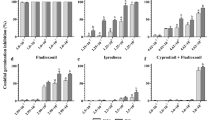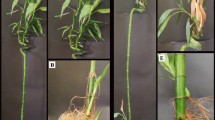Abstract
Sisal—Agave sisalana Perrine ex. Engelm—is a key economical and social crop in the semi-arid region of Brazil, especially in the Bahia state. Sisal is severely affected by Aspergillus niger Thieg, the causal agent of sisal red rot. Currently, existing control strategies are fruitless. Here, we tested different homeopathic drugs Carbo vegetabilis, Ferrum metallicum, Natrum muriaticum, phosphorus and sulphur at centesimal Hahnemannian (CH) dynamizations, of 3CH, 5CH, 7CH, 9CH and 12CH, on Aspergillus niger. We measured in vitro growth inhibition, sporulation and germination of Aspergillus niger during 12 days. We assessed in planta Aspergillus niger incidence and disease severity. Our results show that homeopathic drugs inhibited Aspergillus niger growth in vitro, in a dynamization-dependent way. Natrum muriaticum 5CH revealed the higher inhibition of 66 %, whereas sulphur 5CH yielded the lowest inhibition of 6.4 %. Spore production was stimulated using all homeopathic drugs at all dynamization levels, whereas spore germination was reduced. In planta assays revealed different results from in vitro assays, corroborating that in planta and in vitro effectiveness is different according to the homeopathic drugs applied. Here, disease incidence was not reduced significantly, but disease severity was lower in treated plants, of 27.8 % using Ferrum metallicum 9CH than in control trials, of 73.6 %. Overall, our findings suggest that homeopathic drugs could be a good strategy to control Aspergillus niger incidence in sisal plants.


Similar content being viewed by others
References
Bee S, Atri DC (2013) Inhibitory effect of homeopathic drugs on the production of aflatoxin B1 in groundnuts. Int J Pharm Pharm Sci 5:73–75
Betti L, Trebbi G, Majewsky V, Schen C, Shah-Rossi D, Jäger T, Baumgartner S (2009) Use of homeopathic preparations in phytopathological models and in field trials: a critical review. Homeopathy 98:244–266. doi:10.1016/j.homp.2009.09.008
Betti L, Trebbi G, Olioso D, Marzoto M, Bellavite P (2013) Basic research in homeopathy and ultra-high dilutions: what progress is being made? Homeopathy 102:151–154. doi:10.1016/j.homp.2013.01.002
Bonato CM, Viotto EG, Hara JH, Reis B, Myzote AT, Cisneiros JA (2006) The application of the homeopathic drugs Lachesis and Isotherarapic Virus in the growth and infection control for SCMV in sorghum Moench) (Sorghum bicolor (L.) Moench). Cultura Homeopática Arquivos da Escola de Homeopatia 16:51
Carneiro SMTPG, Romano EDB, Pignoni E, Teixeira MZ, Vasconcelos MEC, Gomes JC (2010) Effect of biotherapic of Alternaria solani on the early blight of tomato-plant and the in vitro development of the fungus. Int J High Dilution Res 33:147–155
Casali VWD, Andrade FMC, Duarte ESM (2009) Acologia de Altas Diluições. Resultados científicos e experiências sobre o uso de preparados homeopáticos em sistemas vivos. Imprensa Universitária da Universidade Federal de Viçosa, Viçosa
Chaurasia JP, Vyas KM (1997) In vivo evaluation of some homoeopathic drugs against betelvine Phytophthora disease. Indian Phytopathol 50:542–547
Coutinho WM, Suassuna ND, Luz CM, Suinaga FA, Silva ORRF (2006) Bole rot of sisal caused by Aspergillus niger in Brazil. Fitopatol Bras 31:605. doi:10.1590/S0100-41582006000600014
Damveld RA, Arentshorst M, Franken A, vanKuyk PA, Klis FM, van den Hondel CAMJJ, Ram AFJ (2005) The Aspergillus niger MADS-box transcription factor RImA is required for cell wall reinforcement in response to cell wall stress. Mol Microbiol 58:305–319. doi:10.1111/j-1365-2958.2005.04827.x
FAO (2014) FAO STAT database. http://faostat.fao.org/. Accessed 24 Mar 2014
FHB (2011) Farmacopéia Homeopática Brasileira, 3rd edn. Brasília
Gutiérrez A, Rodríguez IM, Río JC (2008) Chemical composition of lipophilic extractives from sisal (Agave sisalana) fibers. Ind Crop Prod 28:81–87. doi:10.1016/j.indcrop.2008.01.008
Hahnemann (1842) Organon of medicine. Translated from German 6th Edition by Castro C, Filho R, Curi K (1995) 2nd Brazilian Edition. São Paulo. GEHSP, Benoit Mure
IBGE SIDRA (2014) Instituto Brasileiro de Geografia e Estatística. Sistema IBGE de Recuperação Automática. http://www.sidra.ibge.gov.br/. Accessed 27 Mar 2014
Javed MT, Khan MA, Ehetisham-ul-Haq M, Atiq M (2013) Biological management of bacterial blight of cotton caused by Xanthomonas campestris pv. malvacearum through plant extracts and homeopathic products. Res J Plant Dis Pathol 1:1–10
Kehri KH, Chandra S (1986) Control of Botryodiplodia rot of guava with a homeopathic drug. Natl Acad Sci Lett 9:301–302
Khanna KK (1993) Suppression of Fusarium oxysporum Schlecht a pathogen causing seedling blight and foot rot of wheat, with homoeopathic drugs. Natl Acad Sci Lett 63:353–360
Khanna KK, Chandra S (1978) A homeopathic drug controls mango fruit rot caused by Pestalotia magnifaere Henn. Experientia 34:1167–1168
Khanna KK, Khanna KK, Chandra S (1989) Effect of homoeopathic drugs on seed mycoflora of wheat. Natl Acad Sci Lett 12:39–41
Kolisko E, Kolisko L (1978) Agriculture of tomorrow. Acorn Press, Bournemouth
McKinney HH (1925) Influence of soil temperature and moisture on infection of wheat seedlings by Helminthosporium sativum. J Agric Res 26:195–218
Mishra N (1983) Inhibition of Aspergillus niger van Tiegh. By homeopathic drugs causing deterioration of coriander and cumin seeds in storage. Natl Acad Sci Lett 6:139–141
Ram AFJ, Arentshorst M, Damveld RA, vanKuyk PA, Klis FM, van den Hondel CAMJJ (2004) The cell wall stress response in Aspergillus niger involves increased expression of the glutamine:fructose-6-phosphate amidotransferase-encoding gene (gfaA) and increased deposition of chitin in the cell wall. Microbiology 150:3315–3326
Russell AD (2003) Similarities and differences in the response of microorganisms to biocides. J Antimicrob Chemother 52:750–763. doi:10.1093/jac/dkg422
Sá JO (2009) Patogênese de Aspergillus niger e biocontrole da podridão vermelha do sisal por Trichoderma spp. Dissertation, Universidade Federal do Recôncavo da Bahia
Shah-Rossi D, Heusser P, Baumgartner S (2009) Homeopathic treatment of Arabidopsis thaliana plants infected with Pseudomonas syringae. Sci World J 9:323–330. doi:10.1100/tsw.2009.38
Sinha KK, Singh P (1983) Homeopathic drugs—inhibitors of growth and aflatoxin production by Aspergillus parasiticus. Indian Phytopathol 36:356–357
Toledo MV, Stangarlin JR, Bonato CM (2011) Homeopathy for the control of plant pathogens. In: Méndez-Vilas A (ed) Science against microbial pathogens: communicating current research and technological advances, vol 2. Formatex Research Center, Badajoz, pp 1063–1067
Williams JH, Phillips TD, Jolly PE, Stiles JK, Jolly CM, Aggarwal D (2004) Human aflatoxicosis in developing countries: a review of toxicology, exposure, potential health consequences, and intervention. Am J Clin Nutr 80:1106–1122
Wyss E, Tamm L, Siebenwirth J, Baumgartner S (2010) Homeopathic preparations to control the rosy apple aphid (Dysaphis plantaginea Pass.). Sci World J 10:38–48. doi:10.1100/tsw.2010.12
Acknowledgments
This study was supported by grants from the “Conselho Nacional de Desenvolvimento Científico e Tecnológico” through the Project “Tecnologia Social na Inclusão Sócio Produtiva dos Agricultores Familiares da Cultura do Sisal”.
Author information
Authors and Affiliations
Corresponding authors
About this article
Cite this article
Gama, E.V.S., Silva, F., Santos, I. et al. Homeopathic drugs to control red rot disease in sisal plants. Agron. Sustain. Dev. 35, 649–656 (2015). https://doi.org/10.1007/s13593-014-0255-0
Accepted:
Published:
Issue Date:
DOI: https://doi.org/10.1007/s13593-014-0255-0




